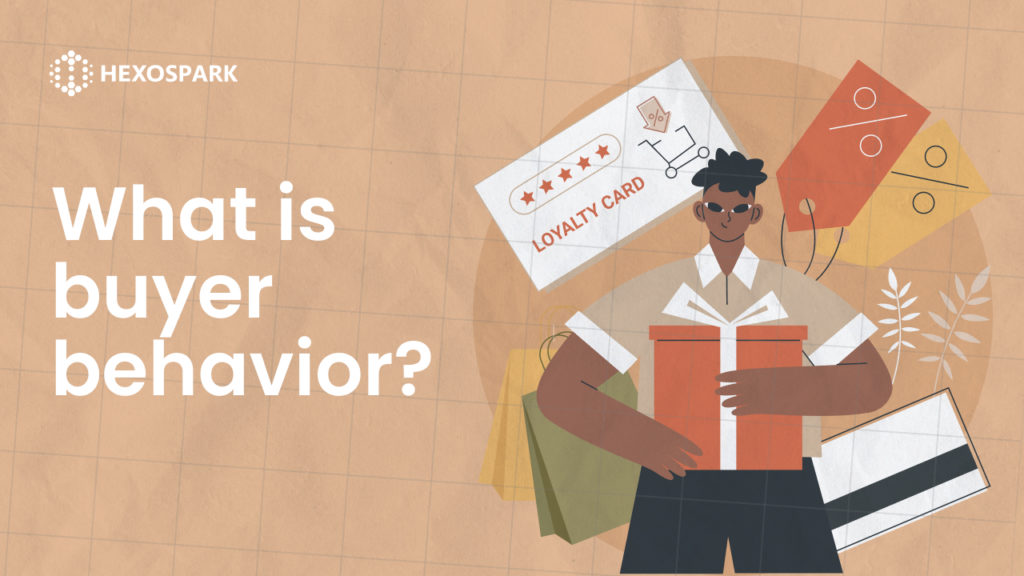Gaining insights into consumer behavior is vital for achieving marketing success and commercial prosperity. Whether you’re a business owner, marketer, or someone interested in human psychology, learning how buyers behave when purchasing this or that product is important.
In this blog, we will delve deep into the details of consumer decision-making, exploring the relevance and impact it holds. Moreover, we will guide you on leveraging this knowledge to enhance your marketing strategies.
Ready? Let’s find out what is buyer behavior first!
What is buyer behavior? Short definition
The decisions and behaviors people or groups take while obtaining goods or services for individual or group consumption are collectively referred to as buyer behavior. Frequently referred to as “consumer buying behavior,” it mainly focuses on consumers as opposed to companies.
Buyer behavior has a big impact on marketing efforts because businesses want to understand why people choose certain products, stick with certain brands, and become customers. To enhance commercial tactics and broaden consumer bases, it is essential to comprehend these factors.
The importance of buyer behavior
The effectiveness of promotional campaigns and the creation of new goods and services across industries depends on an understanding of how customers behave. Businesses can guarantee the creation of successful offerings by analyzing consumer behavior.
Buying behavior encompasses:
- 🔸 The decision-making process people go through when choosing a product.
- 🔸 The elements affecting their decisions.
- 🔸 The impact of family and friends.
- 🔸 The reasons for avoiding a certain product.
With this knowledge, product makers can unlock effective strategies to sell their offerings and cater to consumer preferences.
Main types of buyer behavior
The level of customer involvement and perceived risk plays a crucial role in determining buyer behavior when it comes to purchasing products or services. As the price of a product increases, so does the associated risk, resulting in greater customer involvement in the decision-making process.
Based on these determinants, consumer buyer behavior can be categorized into four distinct types, each characterized by varying levels of customer involvement and perceived risk.
| Buyer Behavior Types | |
| High involvement | Low involvement |
| Complex buying behavior | Habitual buying behavior |
| Dissonance-reducing buying behavior | Variety seeking behavior |
1. Complex buying behavior
Referred to as “extensive” buyer behavior, this type entails high customer involvement and extensive research prior to making a purchase, driven by a significant level of economic or psychological risk. Examples include buying expensive items like houses, cars, or educational courses, where thorough evaluation and consideration are necessary.
2. Dissonance-reducing buying behavior
Dissonance-reducing buying behavior is characterized by significant customer involvement in the purchasing process, often driven by high prices or infrequent purchases. Individuals experiencing dissonance-reducing behavior find it challenging to make brand choices and fear post-purchase regret.
Typically, they opt for convenient options within their budget without extensive research. For instance, when purchasing a coffee maker, a customer may not delve deeply into the various models available but rather choose from a few available brands.
3. Habitual buying behavior
The term “habitual buying behavior” describes how little a consumer participates in the decision-making process. In this group, people tend to perceive little to no difference between brands and frequently repurchase well-known products. Bread, milk, cereals, and other common goods serve as excellent examples of habitual purchasing behavior.
4. Variety seeking behavior
Customers that have variety-seeking behavior switch between companies out of curiosity or novelty rather than out of dissatisfaction demonstrating a low level of interest. For instance, someone might make a decision to buy soap without giving it any thought. The next time, they might pick a different brand to sample a new scent or variant.
What factors affect the buyer behavior process?
Buying behavior is influenced by various factors that businesses need to understand to create effective marketing strategies and meet customer needs. Key factors include psychological factors, social factors, cultural factors, and personal factors.
- 🔸 A buyer’s decision-making process is significantly influenced by psychological factors, which include elements like motivation, perception, learning, attitudes, and beliefs yet are difficult to evaluate precisely.
- 🔸 Humans are social creatures who are impacted by others; hence, social elements are important. As people have a tendency to copy others and seek social acceptance, family, reference groups, roles, and social status have an impact on purchasing decisions.
- 🔸 The beliefs, philosophies, and customs of a particular society or culture have an impact on cultural aspects. Purchase behavior is influenced by culture, subcultures, caste, religion, and other cultural elements.
- 🔸 Each person’s unique needs are particular to them and can have a big impact on their purchasing decisions. Individual differences in age, personal views, income, and way of life influence perceptions and consumer behavior.
Businesses can obtain insights into consumer behavior and modify their marketing tactics to successfully engage and meet the needs of their target audience by taking these aspects into account.
5 main stages of buyer behavior
A five-step model that outlines the steps people take while making decisions about what to buy can be used to examine consumer behavior.
Businesses can get insights into consumer decision-making processes and modify their marketing initiatives to successfully fulfill customer needs at each level by comprehending this five-stage model.
Let’s examine each stage in detail:
1. Recognition needed
Recognizing a need or issue that motivates a consumer to look for a solution is the first step. Both internal (such as hunger or thirst) and external (such as advertising or social influences) causes may trigger these needs.
2. Information lookup
Consumers acquire information to assess the possibilities after determining their needs. To learn more about various companies, goods, and features, they might consult a variety of sources, including commercials, friends, family, and online reviews.
3. Evaluation of potential solutions
Based on their unique criteria and interests, consumers examine and assess several alternatives. At this point, variables including cost, value, brand reputation, and individual values are taken into consideration.
4. Purchase decision
After careful evaluation, consumers make a decision to purchase a particular product or service. The chosen alternative is influenced by various factors, including affordability, perceived value, and emotional considerations.
5. Post-purchase assessment
Consumers evaluate their happiness with the selected good or service after making the purchase. This assessment concludes whether they will make more purchases and whether they are likely to suggest the product to others.
To discover how happy your customers are, you can carry out buyer behavior analysis by checking customer reviews on your product page or asking for feedback from customers who have bought your products.
It’s way easier to do the latter with the help of email outreach tools such as Hexospark. You can filter the email addresses that you need to send the feedback request and send it without having to leave the browser. Moreover, you can automate the process and answer the email addresses directly in Hexospark.


Content Writer | Marketing Specialist
Experienced in writing SaaS and marketing content, helps customers to easily perform web scrapings, automate time-consuming tasks and be informed about latest tech trends with step-by-step tutorials and insider articles.
Follow me on Linkedin



